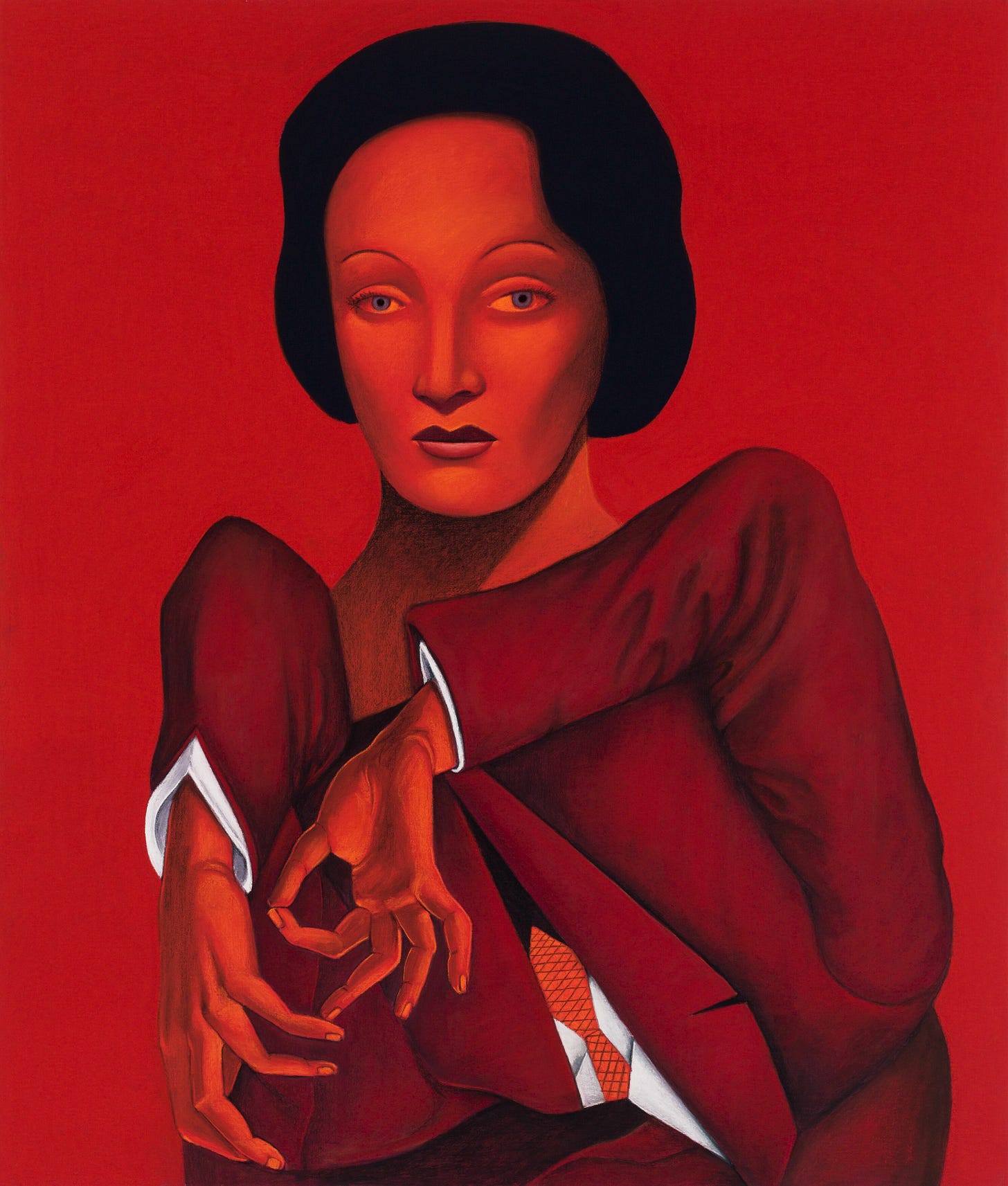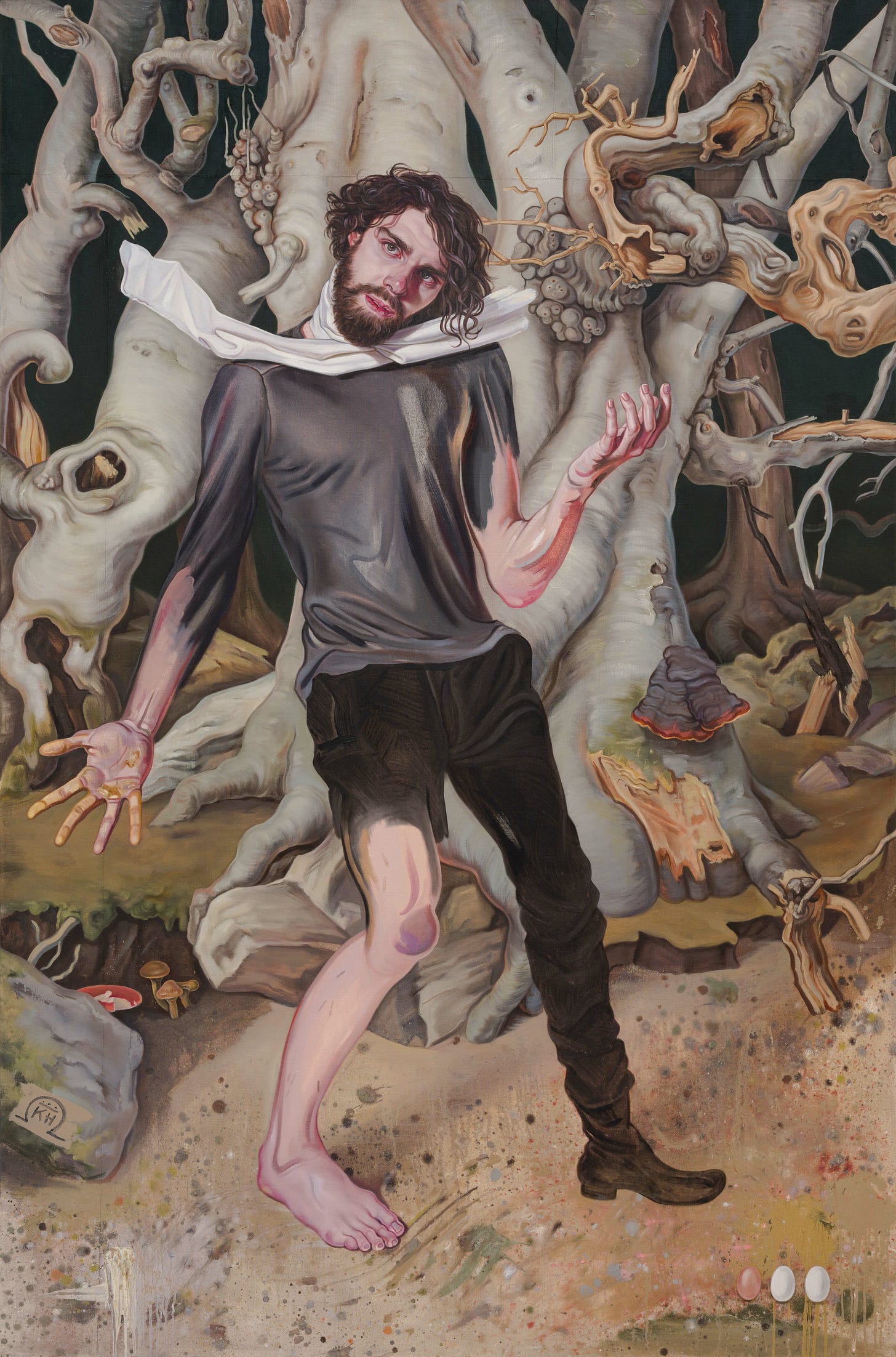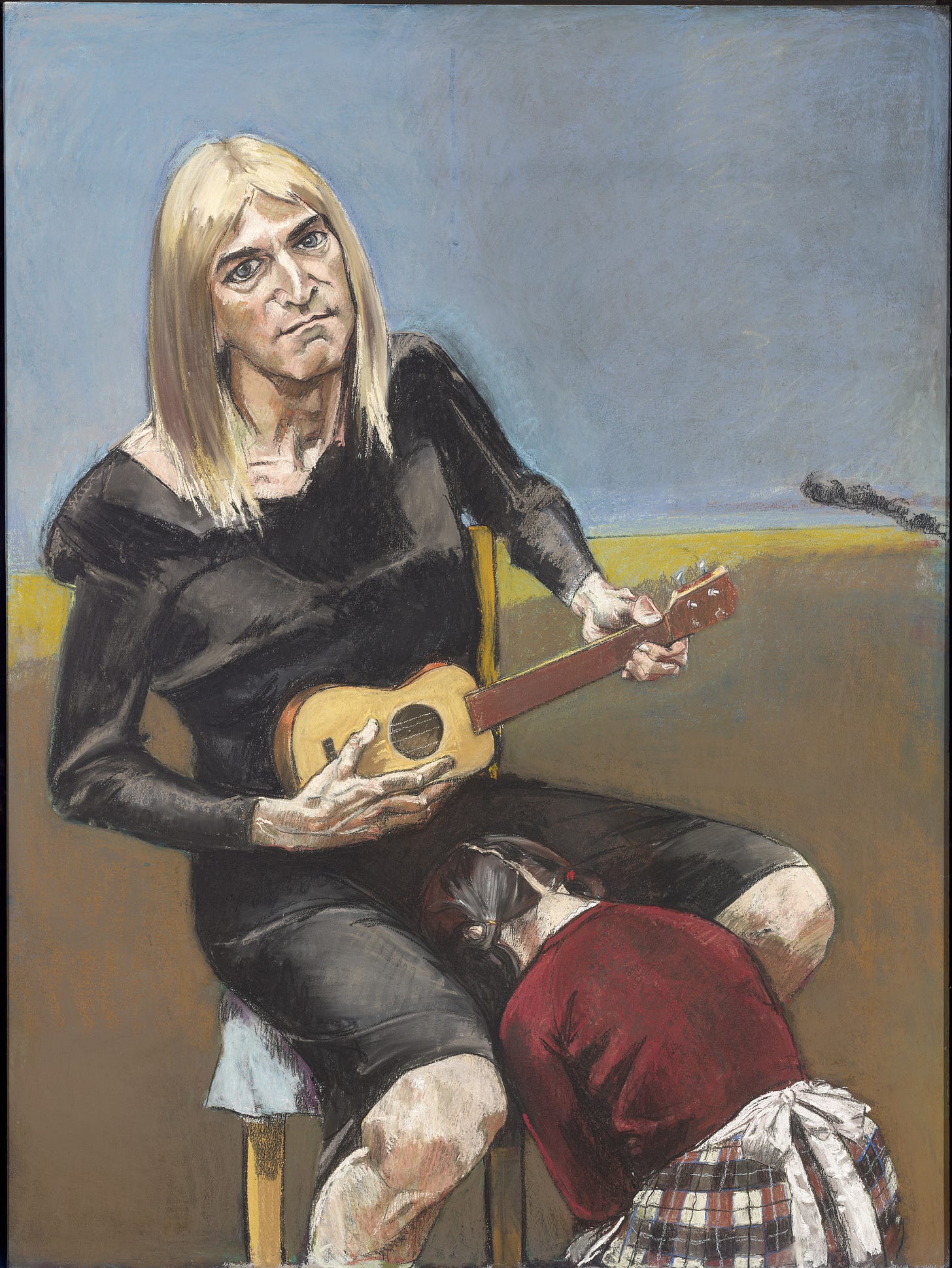Dix Everywhere? The Deichtorhallen Hamburg play "Where is Waldo?" with contemporary art
Hamburg celebrates the legacy of Otto Dix (1891-1969, German) and his importance today. The show mixing past and present reaps mixed results. Buckle up, we've got a lot to cover!
Who is Otto, and why is everyone talking about his dicks?
Otto Dix was part of the New Objectivity movement that emerged in the 1920s. That style isn’t easy to pin down: Instead of getting into feelings and emotions, artists of the New Objectivity sought to show the post-WWI world as it was. They rejected the wild, gestural brushstrokes of Expressionism and went back to more (or less) naturalist painting (some works were borderline caricatures though). No mercy, no empathy, only an ice-cold reality check. The Nazis didn’t vibe with that kind of full-frontal honesty and labeled Otto (along with many artists of that time) as “degenerate”. The spicy relationship between New Objectivity and Nazi art censorship had much more lore but we won’t cover that in one post…
In seven chapters, curator Dr. Ina Jessen (Millenial, German) focuses on two themes: The supposedly apolitical art Otto made during the Nazi regime and the way that contemporary artists look back on him. In this review, we’ll focus on the latter.
But there’s a twist: Instead of showing exclusively Otto’s work, 50 of his pieces (idk if that includes the glass reproduction of his iconic triptych Metropolis (1927-28)) share the hall with 100 artworks by 50 contemporary artists who, as the curator claims, connect to his tradition or were inspired by him.
Is the inspiration in the room with us?
There are certainly works with striking visual resemblance. Yael Bartana (Gen X, Israeli) sampled Otto’s drawings of war veterans for her video Entartete Kunst Lebt [Degenerate Art Lives] (2020). Juan Miguel Pozo’s (Gen X, Cuban) Skat Players (1995) refers explicitly to Otto’s 1920 painting. Nicolas Party’s (Millenial, Swiss) twisted Portrait with a Lawyer (2021) looks more like Otto than he does himself. Otto’s capitalized three-letter surname spelled out on a book spine makes a surprise appearance in Adrian Gheni’s (Gen X, Romanian) Self-Portrait with Favorite Book (2022).
So far so good. The exhibition presents more examples where the parallels are undoubtedly there and the comparison is legit. It’s an easy game. Otto painted big city life, portraits, decadence, war, poverty, nature, and religion. At this point, what artist doesn’t work with at least one of these categories? All you have to do is bring in artists that work with these themes, too! But is this all? Is that the strongest argument you can make for Otto’s relevance today?
Claiming similarities between art from later periods and the work of your chosen artist with the intent to justify their importance today is a lazy argument. You can’t prove the importance of an artwork / a style / an artist because a lot of people still sample it many years later. That’s surely a part of the process. But relevant art stays important in itself. Looking at it provides new insights and new perspectives. Otherwise, it’s just as strong of an argument as if a lot of people believe in it, it must be true.

If anything, Martin Weinhold’s (Gen X, German) portraits of workers build much rather on the legacy of August Sander’s (1876-1964, German) photographic series People of the Twentieth Century. Otto was not the only artist who critically looked at society, condemned the pointless bloodshed of wars, and looked for some form of salvation from suffering. The inclusion of Anselm Kiefer (Baby Boomer, Austro-German) in shows right now is becoming inflationary, for God’s sake…
Mariele Neudecker (Gen X, German) fills tanks with smoke imitating misty forests. Her work I Don‘t Know How I Resisted The Urge To Run (1998) in this show is connected to Otto’s interest in landscapes. In the Kunsthalle next door, Mariele’s tanks bear evidence of contemporary interest in the romantic landscape painter Caspar David Friedrich (1774-1840 German)…
The throwback of the throwback
Two big players in the Hamburg art scene use the same strategy of proving relevance through contemporary reference. Again, it’s not the same as choosing a theme and bringing different artists together for a dialogue. Exhibitions like these force correlation. And as a curator, you can ease your responsibility by claiming that the influence and inspiration are merely indirect. You get to relax while the visitors figure out how exactly the works are related (and obviously, they simply don’t get the point if they don’t see it!)
One chapter of the exhibition focuses on Otto’s fascination with the Old Masters. And that’s where the exhibition shoots itself in the leg. Let me give you an example: In their art, John Currin (Baby Boomer, American) and Anne Laure Sachriste (Gen X, French) directly refer to Lucas Cranach the Elder (ca. 1472-1553, German). So did Otto on many occasions. Therefore, Otto’s legacy continues in John’s and Anne Laure’s work… If the shortest distance between two points is a straight line, then why are we taking this detour?
The same goes for the landscapes of Friedrich Kunath (Gen X, German). He takes landscape paintings from the Romantic period and sprinkles some irony and meta-humor on top. So why on earth would these paintings be related to Otto’s art? Cause he happened to paint landscapes that - oh wonder - were also inspired by Romanticism? There’s a surplus variable in this equation and it’s an O.

Addressing the fat ass elephant in the room
Apart from all the minor considerations I had for the perspectives of this exhibition, I was horrified at how the institution decided to deal with Otto’s sexualization of girls.
The exhibition includes two paintings by Otto depicting girls with both a violent and an erotic subtext. The first is Venus with Gloves (1932): It’s a naked girl. And when I say girl, I mean a child that hasn’t even gone through puberty yet. This girl with barely developing breasts and hips is set against a dark background that serves no other purpose than to highlight her nudity. She wears dark long gloves, her right hand holding onto the dark garment underneath her exposed pubes. The pieces of clothing here, again, serve no other purpose than to highlight that she’s nude.
To be naked is to be oneself. To be nude is to be seen naked by others and yet not recognized for oneself. A nude has to be seen as an object in order to be a nude.
- John Berger
The title Venus with Gloves directly connects the image with sexuality by calling this girl the Goddess of sex and love. What does the curator have to say to that? Instead of critically engaging with this work, the wall label simply frames this child as “a very young woman”. If she’s not explicitly underage, it’s none of our problem…case closed…?
As if that wasn’t enough, another highly sensitive painting is displayed right next to Paula Rego’s (1935-2022, British-Portuguese) Olga. Paula’s paintings are dominated by an imbalance of power, involuntary sexual tension, and an intuitive gut feeling that something in what is infront of us is very, very messed up. In Paula’s Olga, an ambivalent blond figure in a dress and with a striking face sits on a chair playing a string instrument. A girl is on her knees, turning away from the viewer, her head placed in that figure’s lap. While Paula’s works are explicitly dealing with sexual violence, the curator seems to brush over this aspect of Otto’s work.
The painting in question is Kleine Ankündigung (1950): A small girl looks away uncomfortably as a dove descends from the upper left corner. The huge proportions of the chair emphasize her childish height. She clutches her hand tightly over her lap. This scene is Otto’s take on the annunciation, the biblical story of Mary visited by Arcangel Gabriel bearing news: She’ll give birth to the Son of God. Again, instead of interrogating Otto’s choice of visually connecting a child to unwanted pregnancy (be it predatory or critically), the wall label interprets the child as “an ashamed girl physically and mentally resisting the dove as a symbol of the Holy Spirit.”
When I saw that painting, my mind immediately went to Dante Gabriel Rosetti’s (1828-1882, British) Ecce Ancila Domini (1840-50): Mary is scared. Her eyes stare into nothing as Gabriel approaches her, taking up space. She sits on a bed, her back hunched, leaning against the wall and pulling away from him. She is trapped in a corner. Gabriel’s slitted robe reveals his tight, muscular body. Will the conception really be immaculate? This is such a missed opportunity to get a feminist perspective on Otto’s work. But I guess that wouldn’t fit the convenient narrative…

Denial is a river in Egypt…
There’s a problem with how art history deals with art created during National Socialism. Persecution by the Nazis can’t automatically guarantee a white vest. I don’t like dualisms. Whatever is framed as the opposite of something evil, there’s no more room to look at that thing critically. Positioning Otto on the opposite spectrum of Nazism and its ideological art suggests that Otto’s art must be unproblematic and unideological. There is no critical perspective without nuance.
What an artist is interested in isn’t enough. And topics are not enough to glue artists together. It’s how exactly they approach a theme. It’s the unique perspective that we should look for. Not themes they have in common. I would find it much more interesting to leave Otto’s influence and instead look at New Objectivity as a whole: Otto wasn’t the only one painting in this style. What inspires artists of this day and age to look at our world through the lens of New Objectivity? Instead, all we get here is the chewed-through legend of the artist as a genius whom others can’t help but look up to.
If you wanna search for Otto, you better don’t forget your microscope when visiting Dix and the Present, until April 1, 2024, at Deichtorhallen Hamburg.
Deichtorhallen Hamburg
Deichtorstrasse 1-2
20095 Hamburg
Website
Instagram: @deichtorhallenhamburg
Had to share this hot take this time. Am I being harsh or do you see what I see? Share your thoughts in the comments or leave a like. And maybe you’d like to share.
See you soon!!!
Jennifer
The Gen Z Art Critic






